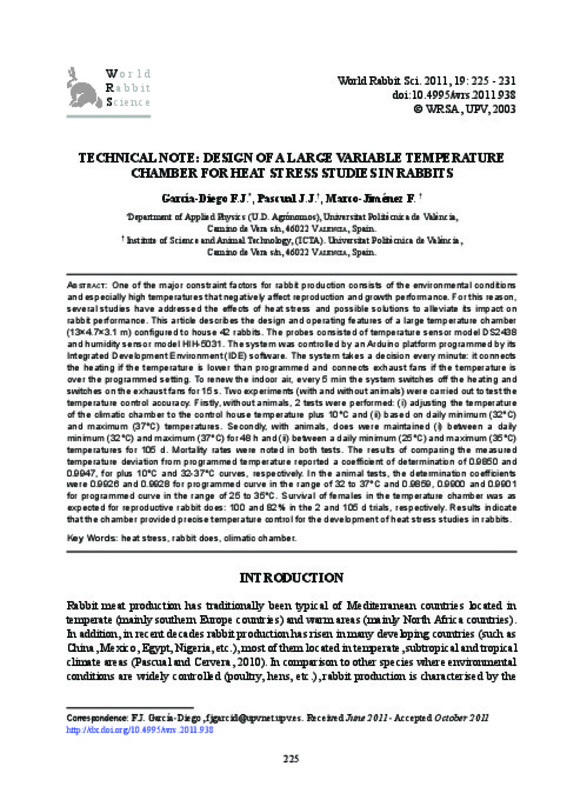JavaScript is disabled for your browser. Some features of this site may not work without it.
Buscar en RiuNet
Listar
Mi cuenta
Estadísticas
Ayuda RiuNet
Admin. UPV
Technical Note: Design of a large variable temperature chamber for heat stress studies in rabbits
Mostrar el registro sencillo del ítem
Ficheros en el ítem
| dc.contributor.author | García Diego, Fernando Juan
|
es_ES |
| dc.contributor.author | Pascual Amorós, Juan José
|
es_ES |
| dc.contributor.author | Marco Jiménez, Francisco
|
es_ES |
| dc.date.accessioned | 2012-01-11T10:59:24Z | |
| dc.date.issued | 2011 | |
| dc.identifier.issn | 1257-5011 | |
| dc.identifier.uri | http://hdl.handle.net/10251/14330 | |
| dc.description.abstract | [EN] One of the major constraint factors for rabbit production consists of the environmental conditions and especially high temperatures that negatively affect reproduction and growth performance. For this reason, several studies have addressed the effects of heat stress and possible solutions to alleviate its impact on rabbit performance. This article describes the design and operating features of a large temperature chamber (13x4.7x3.1 m) configured to house 42 rabbits. The probes consisted of temperature sensor model DS2438 and humidity sensor model HIH-5031. The system was controlled by an Arduino platform programmed by its Integrated Development Environment (IDE) software. The system takes a decision every minute: it connects the heating if the temperature is lower than programmed and connects exhaust fans if the temperature is over the programmed setting. To renew the indoor air, every 5 min the system switches off the heating and switches on the exhaust fans for 15 sec. Two experiments (with and without animals) were carried out to test the temperature control accuracy. Firstly, without animals, two tests were performed: (i) adjusting the temperature of the climatic chamber to the control house temperature plus 10ºC and (ii) based on daily minimum (32ºC) and maximum (37ºC) temperatures. Secondly, with animals, does were maintained (i) between a daily minimum (32ºC) and maximum (37ºC) for 48 h and (ii) between a daily minimum (25ºC) and maximum (35ºC) temperatures for 105 d. Mortality rates were noted in both tests. The results of comparing the measured temperature deviation from programmed temperature reported a coefficient of determination of 0.9850 and 0.9947, for plus 10ºC and 32-37ºC curves, respectively. In the animal tests, the determination coefficients were 0.9926 and 0.9928 for programmed curve in the range of 32 to 37ºC and 0.9859, 0.9900 and 0.9901 for programmed curve in the range of 25 to 35ºC. Survival of females in the temperature chamber was as expected for reproductive rabbit does: 100 and 82% in the 2 and 105 d trials, respectively. Results indicate that the chamber provided precise temperature control for the development of heat stress studies in rabbits. | es_ES |
| dc.description.sponsorship | This work was supported by the Spanish Research Project (CICYT AGL2008-03274) and the Spanish "Ministry of Science and Innovation" HAR2010-21944-C02-01 and HAR2010-21944-C02-02. | en_EN |
| dc.language | Inglés | es_ES |
| dc.publisher | Editorial Universitat Politècnica de València | es_ES |
| dc.relation.ispartof | World Rabbit Science | |
| dc.rights | Reserva de todos los derechos | es_ES |
| dc.subject | Heat stress | es_ES |
| dc.subject | Rabbit does | es_ES |
| dc.subject | Climatic chamber | es_ES |
| dc.title | Technical Note: Design of a large variable temperature chamber for heat stress studies in rabbits | es_ES |
| dc.type | Artículo | es_ES |
| dc.date.updated | 2012-01-09T13:58:47Z | |
| dc.identifier.doi | 10.4995/wrs.2011.938 | |
| dc.relation.projectID | info:eu-repo/grantAgreement/MICINN//AGL2008-03274/ES/MEJORA GENETICA DEL CONEJO DE CARNE: REPRODUCCION, ESTRES Y LONGEVIDAD/ | |
| dc.relation.projectID | info:eu-repo/grantAgreement/MICINN//HAR2010-21944-C02-01/ES/CARACTERIZACION MICROCLIMATICA DE OBRAS DE ARTE ENFOCADA A LA CONSERVACION PREVENTIVA DE LAS MISMAS/ | |
| dc.relation.projectID | info:eu-repo/grantAgreement/MICINN//HAR2010-21944-C02-02/ES/MONITORIZACION Y ESTUDIO DE DEGRADACION EN OBRAS DE ARTE ENFOCADO A LA CONSERVACION PREVENTIVA DE LAS MISMAS./ | |
| dc.rights.accessRights | Abierto | es_ES |
| dc.contributor.affiliation | Universitat Politècnica de València. Departamento de Física Aplicada - Departament de Física Aplicada | es_ES |
| dc.contributor.affiliation | Universitat Politècnica de València. Centro de Investigación Acuicultura y Medio Ambiente - Centre d'Investigació Aqüicultura i Medi Ambient | es_ES |
| dc.contributor.affiliation | Universitat Politècnica de València. Instituto de Ciencia y Tecnología Animal - Institut de Ciència i Tecnologia Animal | es_ES |
| dc.contributor.affiliation | Universitat Politècnica de València. Escuela Técnica Superior de Ingenieros Industriales - Escola Tècnica Superior d'Enginyers Industrials | es_ES |
| dc.contributor.affiliation | Universitat Politècnica de València. Departamento de Ciencia Animal - Departament de Ciència Animal | es_ES |
| dc.contributor.affiliation | Universitat Politècnica de València. Escuela Técnica Superior de Ingeniería Agronómica y del Medio Natural - Escola Tècnica Superior d'Enginyeria Agronòmica i del Medi Natural | es_ES |
| dc.description.bibliographicCitation | García Diego, FJ.; Pascual Amorós, JJ.; Marco Jiménez, F. (2011). Technical Note: Design of a large variable temperature chamber for heat stress studies in rabbits. World Rabbit Science. 19(4). https://doi.org/10.4995/wrs.2011.938 | es_ES |
| dc.description.accrualMethod | SWORD | es_ES |
| dc.relation.publisherversion | http://doi.org/10.4995/wrs.2011.938 | |
| dc.description.volume | 19 | |
| dc.description.issue | 4 | |
| dc.identifier.eissn | 1989-8886 | |
| dc.contributor.funder | Ministerio de Ciencia e Innovación |








